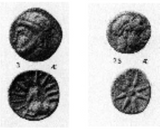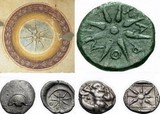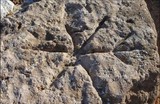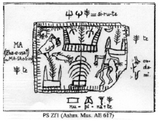If thinking now-days, one could suppose that the tablet's writer intentionally wanted to make fool of all of us, his/or her folowers, wich is totally excluded.Radher was kind of schollar wich wanted to show/teach somebody writing evolution and basic principles.
No one with sound mind ( I mean the writer) could foresee that thousends years after, hundred of scientists are seeing the tablets as an extremely weird, extraterestrial-like items.
From https://en.wikipedia.org/wiki/T%C4%83rt%C4%83ria_tablets :
"The meaning (if any) of the symbols is unknown, and their nature has been the subject of much debate. Scholars who conclude that the inscribed symbols are writing base their assessment on a few assumptions which are not universally endorsed. First, the existence of similar signs on other artifacts of the Danube civilization suggest that there was an inventory of standard shapes used by scribes. Second, the symbols are highly standardized and have a rectilinear shape comparable to that manifested by archaic writing systems. Third, the information communicated by each character was specific, with an unequivocal meaning. Finally, the inscriptions are sequenced in rows, whether horizontal, vertical or circular. If they do comprise a script, it is not known what kind of writing system they represent. Some archaeologists who support the idea that they do represent writing, notably Marija Gimbutas, have proposed that they are fragments of a system dubbed the Old European Script."
Even if many of them are claiming (without proof) that they are carring some form of writing, only a few made rather cissy /milquetoast/ sissy attempts.One must discerne between Vinca (symbol systems) and Tartaria tablets (sign/writing system).
From Apprehending the semiotics of global typography: A Systemic Functional Grammar approach of Japanese and Latin typefaces file:///C:/Users/User/Downloads/bu-dc33-pue-full.pdf
"However, the authenticity of the Vinča tablets as part of the 6,500 years old civilization is debated amongst scholars (Hood, 1967), for some think they might have been re-written centuries after the end of the civilization. However clever, the Vinča system is considered a symbol system, not a sign system, and therefore not a writing one. “A ‘symbol’ is a graphic mark that stands for something else, while a ‘sign’ is a conventional component of a writing system (Fischer, 2003)."
by DG Zanotti - 1983
EUROPEAN COPPER AGE. Since their ... See also S. Hood, "The Tartaria Tablets," Scientific American .... 3300 and 3000 B.C.,'8 or contemporary with the Uruk.
J. P. Mallory, Douglas Q. Adams - 1997 - Foreign Language Study
[E.C.P] TARTARIA TABLETS A Neolithic settlement in Romania, Tartaria ... that the tablets derived from a pit that was initially dug from a higher level, i.e., the ...
Sarunas Milisauskas - 2011 - Social Science
Tartaria is a low mound (250 × 100 meters), the lowest levels of which contain ... the pit is not Vinˇca, but intrudes into the Vinˇca level from later and higher levels. The tablets were found in trench G. Zanotti (1983:212) has suggested that they ...I will show you in a few steps .having the round tablet as example (I stressed for many years before)that has true writing on it.
The problem remain only what specific people and writing is involved.
I will show you how the upper half contain true writing using old greek and latin languages.
More than this, I will show you how the right side could contain in more than 3 forms the name of god.
=================================================================
To speed up those steps, fast about left side:
Letters HP or HD
In fact archaic eta=HETA wich in early hreek whas pronounced as consonant H, ionians first renounced in favor of vocalic E (same cretans).
From http://www.carolandray.plus.com/Eteocretan/archaic_alpha.html
- ḥēt
 whose sound was /ħ/ (voiceless pharyngeal fricative). Speakers of western Greek and other dialects, which retained the ancient Greek /h/, used this letter for their /h/, calling it "hēta". But those dialects, such as most of the Ionian dialects and Cretan Doric, that "dropped their aitches" simply called it "ēta"and used it from the start to denote the long low-mid vowel /ɛː/. This was always the usage in the archaic Cretan alphabets.
whose sound was /ħ/ (voiceless pharyngeal fricative). Speakers of western Greek and other dialects, which retained the ancient Greek /h/, used this letter for their /h/, calling it "hēta". But those dialects, such as most of the Ionian dialects and Cretan Doric, that "dropped their aitches" simply called it "ēta"and used it from the start to denote the long low-mid vowel /ɛː/. This was always the usage in the archaic Cretan alphabets.
In West Mediteranean areas continued as nowdays H.
The reading could be, Heros/gr. Hero,Ero/lat. :"Lord"
Latin Alternative forms herus Etymology From Proto-Italic *eros (“master”), from Proto-Indo-European *h₁esh₂ós (“master”). Cognate with Hittite 𒅖𒄩𒀀𒀸 (“master”). A connexion with heres (“heir”) and hirudo (“leech”) has also been proposed by Charlton Lewis and Charles Short, making its stem instead from Proto-Indo-European *ǵʰeh₁ro- (“derelict”). Cognates would include Ancient Greek χήρα (khḗra, “widow”), हरति (harati, “to seize”) and हरण (haraṇa, “hand”) Pronunciation (Classical) IPA(key): /ˈe.rus/, [ˈɛ.rʊs] Noun Edit erus m (genitive erī); second declension master of the house or family Inflection Edit Second declension. Case Singular Plural nominative erus erī genitive erī erōrum dative erō erīs accusative erum erōs ablative erō erīs vocative ere erī Synonyms Edit dominus
===================================================================
In the right side,
sign +++++ wich we are lefting aside for a while, even if in eteocretan was used alternate as for Zai or Semk.
From http://www.carolandray.plus.com/Eteocretan/archaic_alpha.html :
- semk
 whose sound was /s/. It is found in some of the archaic alphabets as an alternative way of writing
whose sound was /s/. It is found in some of the archaic alphabets as an alternative way of writing  . It was later used in eastern Ionian alphabets to denote /ks/, but this usage is not attested in any of the archaic alphabets nor known in the alphabets of the western Greeks. The letter occurs in the Praisos #1 inscription and is discussed in the next two sections below.
. It was later used in eastern Ionian alphabets to denote /ks/, but this usage is not attested in any of the archaic alphabets nor known in the alphabets of the western Greeks. The letter occurs in the Praisos #1 inscription and is discussed in the next two sections below.
- zai (zeta):the form
 is found in the Greek inscriptions at Dreros, but does not occur in any of the extant Eteocretan texts. The form
is found in the Greek inscriptions at Dreros, but does not occur in any of the extant Eteocretan texts. The form  is found in some archaic local scripts to spell Greek ζ; this is possibly the case with Praisos #1 inscription.
is found in some archaic local scripts to spell Greek ζ; this is possibly the case with Praisos #1 inscription.
zai (zeta): the sound denoted by this symbol seems to have varied in different Greek dialects. Some instances of classical ζ derive from earlier /sd/, e.g. ἵζω (hizo) "I seat" ← *si-sd-ō (cf. Latin: sīdō). The majority of cases, however, derive from a earlier */dj/, */gj/ suggesting that sound denoted by 'z' in transcriptions of Mycenaean Linear B was /dj/ or an affricate such as [ʤ] or [ʣ]. It would seem, however, that in the archaic and classical periods, by a process of assimilation or metathesis, the sound varied in the dialects between [dd], [zd] and [zz] with the latter becoming the norm by the Hellenistic period and giving way eventually to the modern Greek [z].
In Cretan Greek [dd] was the norm and the spelling δδ is also found. But there appears to have been a tendency in Crete to devoice this combination as ττ is also found for standard Greek ζ; indeed, we also occassionally find actual /tt/ spelled ζ.
For the above, see: M. Lejeune, Phonétique historique du Mycénien et du Grec ancien, Paris, 1972, pp112 sqq.; W.S. Allen, Vox Graeca, Cambridge UK, 1968, pp. 53 sqq.; C.D. Buck, The Greek Dialects, Chicago, 1955, p. 71 sq., and pp. 313 sqq. However, the letter
 does not occur in any of the extant Eteocretan texts, so it may not directly concern us here, unless....
does not occur in any of the extant Eteocretan texts, so it may not directly concern us here, unless....- semk: If
 is not a local variant of
is not a local variant of  , then it must denote some Eteocretan sibilant not found in contemporary Greek (see 'Phonemic Values of Archaic Letters' below).
, then it must denote some Eteocretan sibilant not found in contemporary Greek (see 'Phonemic Values of Archaic Letters' below). - As in some other local scripts, it is merely used as a variant of
 and, therefore, presumably denotes either /dd/ or /tt/.
and, therefore, presumably denotes either /dd/ or /tt/. - It really is semk and is being used to represent a sibilant not known in contemporary Greek. The clear presence of Ϝσ (ws) on Praisos #3 may indicate that Eteocretan possessed a labialized sibilant [sʷ]].
Sign +++++ wich could be Zu as in cretan "Zou to lako" ("Zeus' cave)
1.So Dze?, Zu/Zou :cretan "Zeus"
But the D D o o/ ? D D o c? sequence can give:
2.cretan DDou as eteocretan sign Z was pronounced geminate D ("DD"). See above.
DDou as Dzou/Zdeu/Zou
3.This phonetic gemination lasted till nowdays in neapolitan,corsican maybe spanish Ddio...........(and in Romania some tens years before proposal to write god close to latin as Ddeu)
so DDoo=Ddou for Zeou,Zou
4.Look at the picture, 1-st from right,
http://imgfrm.index.hu/imgfrm/7/5/4/0/BIG_0001077540.jpg

see an I like inside first D.(probably when cuneus left the surface for I left aditional unintended scratch?)See also how second D has extended vertical bar upward
so Di b o c
dibos pronounced DiVos
Curtius [1] has hinted to the possibility that some present forms of the word Theos could have evolved from the root/concept relating to divos, but he did not provide complete and convincing arguments mainly because he did not consider the Slavic languages as platforms for his interpretation. He quotes the Italian etymologist Ascoli [10] who identified ‘Theos’ with the Sanskrit root div and divja-s ‘heavenly’ and from div-eo-s arrived at dveos and theos:
divos > dibos > qibos > qeios > qeos
3. Genitive: Διος (Dios) in Greek and दिवः (divaḥ) in Sanskrit. The remaining cases are constructed on an alternative root div-. What is immediately evident is that the Greek form lacks the sound v. This is due to the fact that this sound was entirely lost in Greek after about 1000 BC. Where there is v in another language, there will always be a blank in Greek. Before this loss the Greek form must have been Divos.
The Inscription of Dvenos - Jstor
https://www.jstor.org › stable
by RG Kent · 1926 · Cited by 3 · Related articles
The archaic Latin inscription known as the Inscription of Duenos, ..... tion of the Greek qi) e LXarbs aoo e~ot K6Prn, ..... [iurat (=adiurat)] Io(vem) Vei(ovem) Sat(urnum) divos .
Note. (Another form "deivos"is found in Duenos inscription)
That divos was used in greek for "god" and in latin for "gods" also divus,divo:"god-like"= "divine"
Common Latin titles explained
https://finds.org.uk/romancoins/articles/page/slug/commontitles
SECOND DECLENSION NOUNS http://www.cultus.hk/Latin_vocab/noun1245/divus.html
| SINGULAR | PLURAL | |
| NOM. | ||
| GEN. | ||
| DAT. | ||
| ACC. | ||
| ABL. |
From https://en.wiktionary.org/wiki/divus#Latin
dīvus (feminine dīva, neuter dīvum); first/second declension
Phrygian areyasti - Core
https://core.ac.uk/download/pdf/15590710.pdf
by A LUBOTSKY
63): "Bonok the dedicator keeps (his) vow, wherefore (the god) healed her ..... of the OPhr. inscription are unclear, which makes this identification of devos and ...The common origin of the Gods names Yahweh (Jehovah) and Zeus ...
www.garshin.ru › Linguistics › Comparativistics
Keywords: origin of the god's names, Supreme Gods, Lord of the day, .... Iranian: patat Dywos - god-father Divos;; Armenian: tiw- day;; Ancient Greek: Zeus (Nom.) ...... the ancestor another phratrias Armenians Hayk, the Phrygian god in Lydia ...
Religions and Cults in Pannonia. Exhibiton an Székesfehérvár ... - MEK
mek.oszk.hu/08400/08475/08475.pdf
The only relief of the so-called Thracian Rider-god was found at Sisak. ... deities and of the existence of their sanctuaries sub divo, in a natural environment ..
me: (thracian rider-god Heros,Hero modern rom,"EROu")





